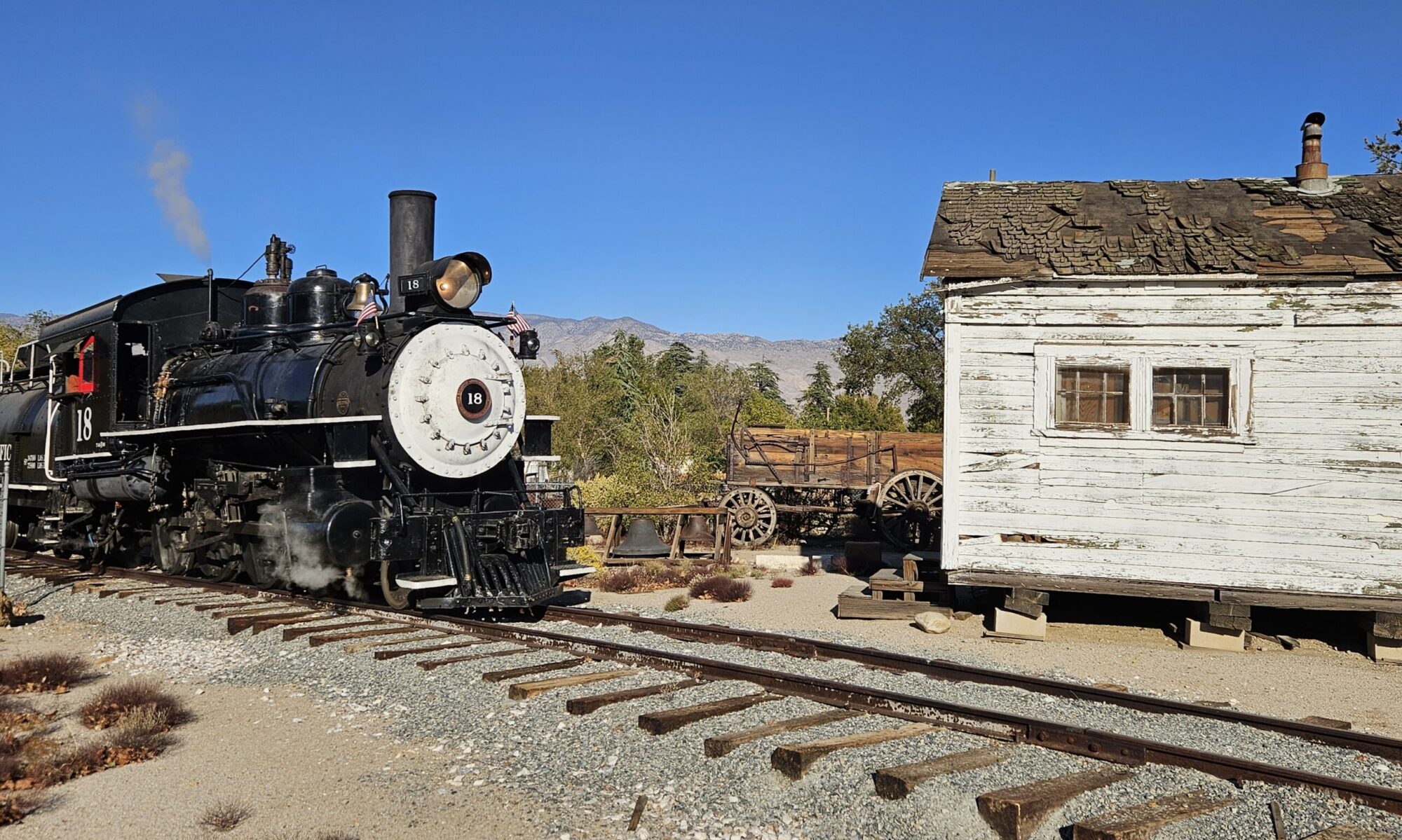


















What a 3 days in August for the #18! We finally steam tested the #18 to make sure all of the flexible staybolts, the boiler patch and generally all the other boiler work we have performed was ready and working properly, it was! Now on to the story…
With things a bit smoky from the wildfire on the other side of the Sierra’s we got to work Thursday with prep work. First off we installed our panel track out about 30 feet, then we went about finishing the last of the plumbing that needed installing, the fuel and atomizer lines. While the plumbing was going on all the boiler plugs and steam fittings were checked for tightness and proper installation. Once all was in order we filled the boiler. With the boiler filling and the panel track down we rolled the locomotive back and forth to verify our main rod lengths between crank pins and wrist pins. This had nothing to do with steaming up the locomotive but is very important for the upcoming rod work. With rod lengths verified it was time to set up our fuel and air sources for Fridays steam test. With the tender over at the Museum we decided the fuel would be provided via a 55 gallon drum on the forklift plumbed into the burner line with gravity transferring the fuel. The fuel was a mixture of filtered waste oil and kerosene, both easily available for the weekend. Air for the draft and atomizer was provided via a rental compressor until sufficient steam pressure could take over. With all in order we pushed the engine back inside the tent, cleaned up, and headed to the Mt. Whitney Fish Hatchery for their annual BBQ dinner fundraiser, despite the smoke in the air a good time was had by all.
Friday dawned with a lot less smoke. After a good breakfast at Jenny’s Café we started the work day by pulling the locomotive outside and re-hooking up all of our fuel and air connections. With all in the ready we had a quick tailgate safety meeting and at about 10am we lit off the fire. With the exception of a leaky firing valve (since repaired) things went flawlessly. There were no unacceptable leaks or issues. The rebuilt burner and blower both worked great and provided us with an easily adjustable fire and draft. By about 2pm we were up to 150psi. Not knowing exactly where the safeties would lift at but guessing it would be around 160 (they were reset from the 180 operating pressure, and will be set back to 180) we decided to try the dynamo. It worked great but will need the governor adjusted once the wiring is hooked up. We also tried the engineers injector. Despite multiple times it almost picked up, we just couldn’t keep enough water going to it from a garden hose and bucket. With a successful test we decided to find where the safety lifted at. 157psi proved to be where. With that we shut off the fire, blew a good whistle for the town and put the engine away. A complete success!
To hear the whistle click here.
And to see a short video of the fire in the fire box as seen through the peep hole click here.
Saturday we went back to work again, this time with a hot locomotive. While no pressure remained, the water was still scalding hot, as was some of the steel. To make it easier to work, we drained the boiler, and once again, pulled the engine outside for some fresh air (the smoke had finally subsided for the most part). We started the work by taking apart some of the cab components and fixtures and also removed both injectors. Then we went to work fitting the insulation both inside and out of the cab. We also mudded all the areas around the flexible sleeves. With the ambient heat on the boiler the mud set up nicely and before you knew it we were putting the back pieces of jacketing in place. This allowed us to reinstall some of the components permanently. Aside from all that, Gary finished up both of the sander valves and installed them while Travis and Bob spent the day fitting all the air lines and brackets which allowed us to get a shopping list of plumbing together for the next time. Finally, we finished the day over at Dave’s shop loading the main and side rods and the new brass for the trip to Durango and their ultimate repair.
What now? While it may seem like we are about done, we still have quite a bit of finicky little things to do as well as a few big things. September will see the finishing of the jacketing and sand dome as well as the first coat of paint. Currently all focus is on getting the locomotive completed in 2016 and to its new home at the Museum.
We will close this post with a couple worth while things to mention:
Please mark your calendars for October 17th in Independence. That Saturday will be our annual BBQ fundraiser and the locomotive will be available for viewing. Also, we have been in the process of changing our website hosts to improve the reliability and speed of our site, with the transition a few things did not transfer exactly. Please be patient as we get these minor bugs ironed out and in the process update and improve pages and pictures.
As always thank you all! And please check out our catalog for your official #18 merchandise. And if you aren’t already, become a member and help us take the restoration to completion!

You must be logged in to post a comment.